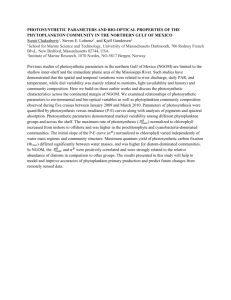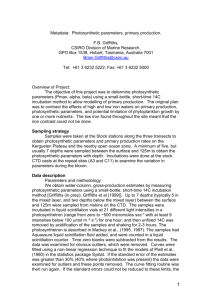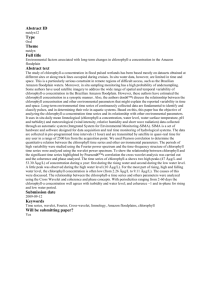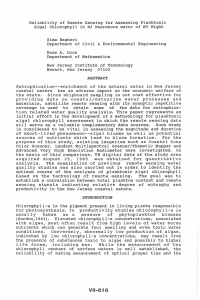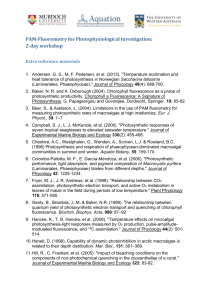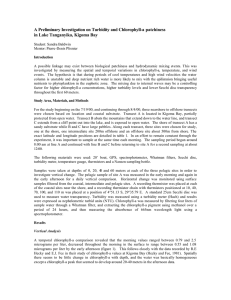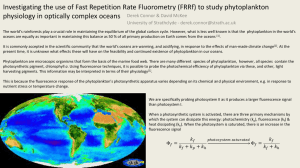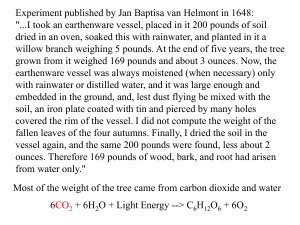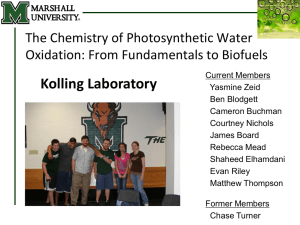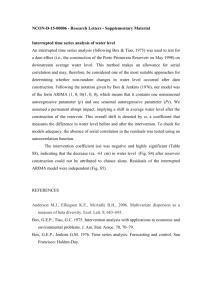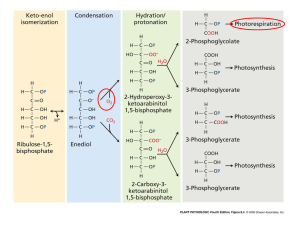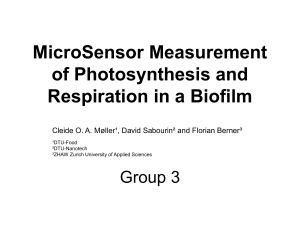ANTARES-4 METADATA
advertisement
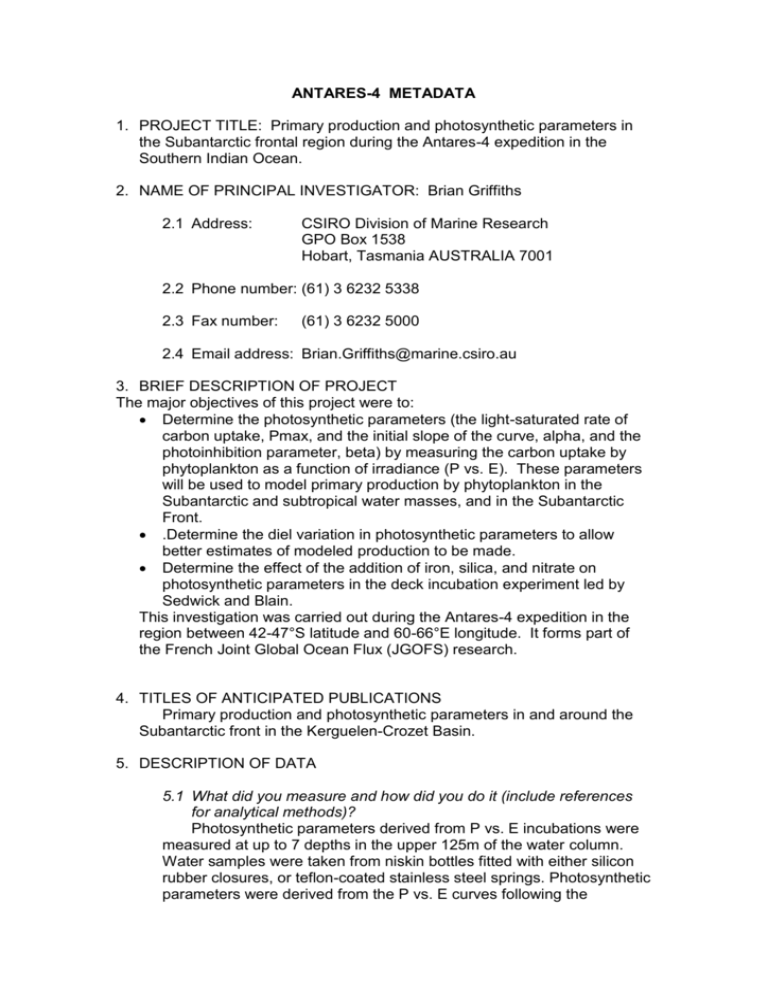
ANTARES-4 METADATA 1. PROJECT TITLE: Primary production and photosynthetic parameters in the Subantarctic frontal region during the Antares-4 expedition in the Southern Indian Ocean. 2. NAME OF PRINCIPAL INVESTIGATOR: Brian Griffiths 2.1 Address: CSIRO Division of Marine Research GPO Box 1538 Hobart, Tasmania AUSTRALIA 7001 2.2 Phone number: (61) 3 6232 5338 2.3 Fax number: (61) 3 6232 5000 2.4 Email address: Brian.Griffiths@marine.csiro.au 3. BRIEF DESCRIPTION OF PROJECT The major objectives of this project were to: Determine the photosynthetic parameters (the light-saturated rate of carbon uptake, Pmax, and the initial slope of the curve, alpha, and the photoinhibition parameter, beta) by measuring the carbon uptake by phytoplankton as a function of irradiance (P vs. E). These parameters will be used to model primary production by phytoplankton in the Subantarctic and subtropical water masses, and in the Subantarctic Front. .Determine the diel variation in photosynthetic parameters to allow better estimates of modeled production to be made. Determine the effect of the addition of iron, silica, and nitrate on photosynthetic parameters in the deck incubation experiment led by Sedwick and Blain. This investigation was carried out during the Antares-4 expedition in the region between 42-47°S latitude and 60-66°E longitude. It forms part of the French Joint Global Ocean Flux (JGOFS) research. 4. TITLES OF ANTICIPATED PUBLICATIONS Primary production and photosynthetic parameters in and around the Subantarctic front in the Kerguelen-Crozet Basin. 5. DESCRIPTION OF DATA 5.1 What did you measure and how did you do it (include references for analytical methods)? Photosynthetic parameters derived from P vs. E incubations were measured at up to 7 depths in the upper 125m of the water column. Water samples were taken from niskin bottles fitted with either silicon rubber closures, or teflon-coated stainless steel springs. Photosynthetic parameters were derived from the P vs. E curves following the procedures given in Platt et al, (1980). The parameters were the maximum photosynthetic rate (P*m ), the initial slope of the P vs. E curve (alpha), and a photoinhibition parameter (beta). Parameters were standardized by dividing by chlorophyll-a to obtain rates of carbon fixation per unit of chlorophyll-a per hour. The chlorophyll-a data was very kindly provided by Dr. M. Fiala. Dr. B. Delille kindly supplied total DIC estimates, which were used in the calculation of uptake rates. The P vs. I incubations were made following the Lewis and Smith (1983) technique and the modifications described in Mackey et al. (1995, 1997). The incubations took one hour, and the P vs. E measurements obtained are close to the gross carbon uptake rate. Temperature in the incubator was controlled by water baths, and typically the shallowest 5 samples were incubated at the mixed layer temperature and the deepest two samples at the average temperature from these two depths. In practice, temperatures were usually within 1.5oC of the temperature at the sampling depth. The light field in the incubator was calibrated at approximately 5 day intervals during the expedition. Estimates of primary production in the water column were obtained using a simple model incorporating the photosynthetic parameters, profiles of chlorophyll-a, extinction coefficients and daily PAR (see Mackey et al 1995, 1997). The fluorescence profiles at each station were converted to profiles of chlorophyll-a by calculating a linear regression between the fluorescence at depths were chlorophyll-a samples were taken. The photosynthetic parameters were determined on the iron and silicate , and iron and nitrate enrichment experiments, and the experiments to determine the Ks value for iron of Sedwick and Blaine. The same procedures were followed, except that column production was not done. Due to space limitations in the incubator, only one of the silicate or nitrate treatments was incubated at each time step. Both of the controls, the plus iron, and plus iron and silicate treatments were incubated, giving duplicate estimates for each of these treatments. The photosynthetic parameters resulting from these experiments have been included in the data being supplied by Blain, and will not be included with the ctd results. 5.2 Sampling strategy: A total of 30 ctd casts were sampled for production vs. irradiance (P vs. E) curves, with 24 ctd casts sampling 7 depths per cast. The remaining 6 casts sampled at two depths (surface and 50m only), but were done at approximately 2 hour intervals to determine how the photosynthetic parameters changed during the day. Sampling depths were chosen to give maximum coverage through the water column to a depth of 125m. Previous experience in the Southern Ocean has shown that primary production below 125m is too low to be measured by this technique. I tried to obtain samples from dawn, noon and late afternoon ctd casts on at least two days per site. In addition, 18 P vs. E experiments were made on the iron enrichment incubation experiments of Sedwick and Blain. 5.3 Post-cruise data analysis/treatment required, and the time frame for this. I require DIC and chlorophyll-a data before the curve fitting to extract the photosynthetic parameters. I anticipate having this data prior to leaving the ship The curve fitting will take about one month. The column production modeling requires calculation of the mixed layer depth, and conversion of the fluorescence to chlorophyll profiles. Once the CTD data is available, the mixed layer depth calculation and the fluorescence to chlorophyll conversion should take several days, and the modeling should take several weeks. 5.4 Error estimates, precision and accuracy of the data? Because non-linear regression techniques are employed to obtain the photosynthetic parameters, error estimates are difficult to obtain. They will depend on the accuracy of the chlorophyll-a and DIC estimates, as well as the phytoplankton uptake. The difference between parameters obtained from duplicate estimates in the iron incubation experiments is typically <10%. A more precise figure will be given when the data are fully analyzed. A discussion of the accuracy of the column production modeling is given in Mackey et al (1997), and is considered to be about 30%. 6. DATA DESCRIPTION 6.1 Data file structure: The data file will be supplied in Excel 7 format. The first, follow the recommended outline put together by Dominique Lefevre. Details of the second data file, containing the column production data will be supplied when the production modeling is done. 6.2 Explanation of headings, units used, abbreviations in data file. Table 1 Pmax: light saturated production rate, in mg Carbon [mg Chlorophyll-a]-1 hour-1. Alpha: the maximum light utilization coefficient, or initial slope of the P-I curve, in mg Carbon [mg Chlorophyll-a]-1 hour-1 [uE m-2 sec-1]-1. Beta: the photoinhibition parameter. It is not present in all samples. The units are mg Carbon [mg Chlorophyll-a]-1 hour-1 [uE m-2 sec-1]-1. The intercept: this is really part of the curve fitting, and is used to check for dark uptake of carbon. It does not feature in the modeling, and has units of mg C [mg Chl a]-1 m-3 h-1. The standard errors given are statistics derived from the curve fitting, and are not error estimates on the parameter itself. 6.3 Estimate of when your data will be submitted to the data base. Table 1 providing chlorophyll-a and DIC data is available at the end of the cruise, in about one month. The production modeling requires surface P.A.R. data in 10 minute averages, and CTD downcast data, including temperature, salinity, and density with depth, and fluorescence profiles before it can be done. Uncalibrated CTD data is ok for the production modeling: I need to calculate the mixed layer depth, and convert the fluorescence profiles to chlorophyll-a profiles before the modeling can be done. Column production data should be available in 3 months. 7. REFERENCES Lewis, M.R. and Smith, J.C. A small-volume, short-incubation time method for the measurement of photosynthesis as a function of irradiance. Marine Ecology Progress Series 13, 99-102, 1983. Mackey, D.J., J.S. Parslow, F.B. Griffiths, H.W. Higgins, and B. Tilbrook Phytoplankton productivity and the carbon cycle in the western Equatorial Pacific under ENSO and non-ENSO conditions. Deep-sea Research 44, 1951-1978, 1998. Mackey, D.J., J.S. Parslow, H.W. Higgins, F.B. Griffiths, and J.E. O’Sullivan. Plankton productivity and biomass in the western Equatorial Pacific: Biological and physical controls. Deep-sea Research 42, 499-533, 1995. Platt, T, C.L. Gallegos and W.G. Harrison. Photoinhibition of photosynthesis in natural assemblages of marine phytoplankton. Journal of Marine Research 38, 687-701, 1980. Table 1: Cruise MD 113 Station ANT4037 Niskin 24 Pmax 1.237 S.E. 0.12 Alpha .O3214 S.E. .0011 Beta .0003 S.E. .00001 Intercept -.23 S.E. .012
